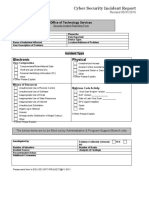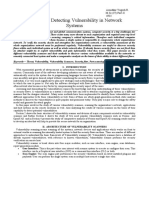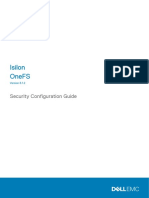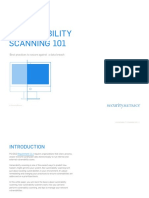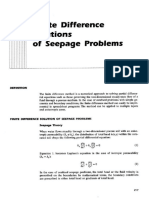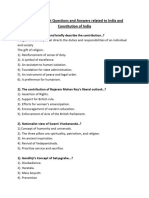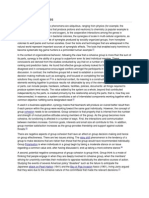Bites-PenTesting
Penetration Test Report
Client:
Date of test:
Due to the removal of sensitive information the formatting of this report has become
slightly off.
D I S C LAI M E R
This report is intended only for the use of the individual or entity
to which it is addressed and may contain information that is privileged, confidential and
exempt from disclosure under applicable law. If the reader of this disclaimer is not the
intended recipient, you are hereby notified that any dissemination, distribution or
copying of this document is strictly prohibited. If you received this document in error,
please notify us immediately by telephone and return the original document to us at the
post address below.
Thank you
�Contents
1
Introduction to the penetration
test . . . . . . . . . . . . . . . . . . . . . . . . . . . . . . . . . . . . .3
1.1 Some definitions. . . . . . . . . . . . . . . . . . . . . . . . . . 3
1.2 Motivation of an attacker.
. . . . . . . . . . . . . . . . . . . . 4
2
The penetration test . . . . . . . . . . . . . . . . . . . . . . . . . . . . . . 5
2.1 Information Gathering. . . . . . . . . . . . . . . . . . . . . . . . . . 5
2.2 Vulnerability Scan . . . . . . . . . . . . . . . . . . . . . . . . . . . . 7
Conclusions and recommendations
3.1 General overview . . . . . . . . . . . . . . . . . . . . . . . . .
3.2 Recommended actions . . . . . . . . . . . . . . . . . . . . . .
17
17
18
�Chapter 1
Introduction to the penetration test
The aim of this penetration test is to help the administrator of the com- pany to
secure the network. Although this report contains technical terms, it has been
written so that a non-initiated reader with a basic knowledge of computing
would understand it. However, references to more technical content, to be
found in the appendices, is given along the test report for the administrator
and security consultant of Bites-PenTesting to review them and possibly
reproduce the test. Should the reader meet difficulties at un- derstanding
the penetration test report, going directly to the Conclusions and
Recommendations section will give him the executive information. For further
help, we remain open to answer any of your questions.
In order to increase the understanding of the reader, some definitions and
clarifications are given in the following sections.
1.1
Some definitions
Hacker: word given by the masse media to define what we will more
accurately call attacker or intruder in this report.
Vulnerability: a bug in computer program that may be abused to gain
privileges on a computer.
Exploit: a program or strategy to exploit a vulnerability. Depending on the
vulnerability, an exploit may be either local, in which a previous local
access to the target computer is required prior gain
higher privileges, or remote where the exploit can be run without this
prerequisite.
Rootkit: a set of programs replacing the tools, that an administrator would
generally use to detect the presence of an intruder, by modified versions
detecting everything but the presence and activities of the intruder, thus
making the administrator confident that the system is free of any
intrusions.
1.2
Motivation of an attacker
There are mainly three reasons why someone might want to penetrate your
network.
� Information theft: to steal valuable information of your business such as
contracts, documents or e-mail communication.
In other words,
information that, for example, competitors may like to know.
Identity theft: by using your network as relay to attack other networks, an
attacker can mask his identity.
Challenge to overcome: to most attackers, your network represents a
challenge that must be conquered or a way to prove their superior
intelligence and technical skills.
Understanding the psychology of an attacker helps considering why your
network is at risk whenever it is connected to the Internet and how to protect it.
Indeed, whatever the final motivation really is, gaining access to a network
always remains a challenge for an attacker. Though intruding a network is
rewarding for his ego, failing to gain the access brings a high level of frustration.
An attacker, usually, doesnt give up easily and will try, again and again, by any
means, to get all kind of information that might be useful to detect weaknesses
and mount attacks.
Therefore, while performing the penetration test, we have been through the
same stages as an attacker would have, even though our strategy or tools might
be slightly differ.
�Chapter 2
The penetration test
The test was carried out from two machines, one running Mac OSX 10.8.9 and the other
a Linux distribution. The Linux machines was rebuild prior to the test to ensure no
information from previous tests could interfere. The OS X machine was used for
information gathering and most of the time did not need to touch the target network.
2.1 .com Network
The first part of the test was targeted at a web server with the address
stipulated in the penetration test agreement as www.emersoncranes.co.uk We
quickly located the IP address for this domain to be 109.75.163.20 by running the
nslookup command on the Linux box
2.2 Footprinting
Prior to any penetration attempts, the very first thing that an attacker needs
to do is gathering as much information as possible. The first process was
mapping the target using the google filters:
site:[target]
site:[target] admin
forced.
insite:[target] login
This shows all target pages.
To locate admin pages that could be brute
To locate any login pages.
Using Google to map the target means we do not directly touch the target network and
therefor do not leave traces of our presence.
No login or admin pages were located using this technique so I ran a python script to
locate admin pages. This also came up empty as no 404 error is produced from the
target when no page is found.
�Using a program call theHarvester I was able to automate the search and use multiple
search engines to find information very quickly for anything relating to the target. The
results were a number of email addresses and sub domains.
The email addresses can now be added to our list of potential user names. As for the sub
domains they will be checked for top level vulnerabilities as they are on the same IP
address to make sure they do not provide a back door into the root directory.
Port Scanning
Next was a scan of all ports on the IP *IP REMOVED* using nmap command:
nmap -sS *IP REMOVED*
This returned the following results:
21/tcp open ftp
22/tcp open ssh
53/tcp open domain
80/tcp open http
110/tcp open pop3
143/tcp open imap
443/tcp open https
587/tcp open submission
993/tcp open imaps
995/tcp open pop3s
1723/tcp closed pptp
3306/tcp open mysql
There are a lot of ports open that I did not expect to see. After our telephone
conversation prior to the penetrations test I was on the understanding that the web server
�was a basic and simple website only. In which case I assume that port 21, 22 and
possible 3306 can be closed.
I did not test any further with 21, 22 and 3306. Port 21 is the first port to attack to gain
entry to a system as it is one of the most un-secure. It would be possible to test them
further with custom packets and I would advise this IF these ports are meant to be open.
Using the switch -sV nmap probes the list of open ports to establish the service running
and what version it is. I ran the list through a database of known vulnerabilities and
none were found.
I then felt it was time to scan the target IP further using OpenVas. This is an open
source application with build in exploits and a vulnerability database. I configured
OpenVas with the target specifications and scan configuration then launched the test.
Returned from the scan were two vulnerabilities:
DNS Amplification Attacks
Port - domain (53/tcp)
cvss base - 5.0
cvss base risk factor - Medium
cve - CVE-2006-0987
Summary:
A misconfigured Domain Name System (DNS) server can be exploited to participate
in a Distributed Denial of Service (DDoS) attack.
A Domain Name Server (DNS) Amplification attack is a popular form of
Distributed Denial of Service (DDoS) that relies on the use of publically
accessible open recursive DNS servers to overwhelm a victim system with DNS
response traffic.
The basic attack technique consists of an attacker sending a DNS name lookup
request to an open recursive DNS server with the source address spoofed to be
the victim's address. When the DNS server sends the DNS record response, it is
sent instead to the victim. Attackers will typically submit a request for as
much zone information as possible to maximize the amplification effect. Because
the size of the response is typically considerably larger than the request, the
attacker is able to amplify the volume of traffic directed at the victim. By
leveraging a botnet to perform additional spoofed DNS queries, an attacker can
produce an overwhelming amount of traffic with little effort. Additionally,
because the responses are legitimate data coming from valid servers, it is
especially difficult to block these types of attacks.
We send a DNS request of 17 bytes and received a response of 436 bytes.
References : URL:http://www.us-cert.gov/ncas/alerts/TA13-088A, URL:http://
www.isotf.org/news/DNS-Amplification-Attacks.pdf, URL:http://web.nvd.nist.gov/
view/vuln/detail?vulnId=CVE-2006-0987
�jolt2
General/tcp
cvss_base - 5.0
cvss base risk factor - Medium
CVE-2000-0482
Summary:
The machine (or a gateway on the network path) crashed when
flooded with incorrectly fragmented packets.
This is known as the jolt2 denial of service attack.
An attacker may use this flaw to shut down this server or router,
thus preventing you from working properly.
Solution:
contact your operating system vendor for a patch.
CVE : CVE-2000-0482
*IMAGE REMOVED*
�Office Network
Using supplied IP address *IP REMOVED* I found the bellow ports open.
PORT STATE SERVICE
80/tcp open http
443/tcp open https
1723/tcp open pptp
8085/tcp open unknown
Then using OpenVas I found one vulnerability.
TCP Sequence Number Approximation Reset Denial of Service Vulnerability.
cvss base - 5.0
cvss base risk factor - Medium
CVE-2004-0230
Summary:
The host is running TCP services and is prone to denial of service
vulnerability.
Vulnerability Detection:
A TCP Reset packet with a different sequence number is sent to
the target. A previously open connection is then checked to see if the target
closed it or not.
Vulnerability Insight:
The flaw is triggered when spoofed TCP Reset packets are received by the
targeted TCP stack and will result in loss of availability for the attacked
TCP services.
Impact:
Successful exploitation will allow remote attackers to guess sequence numbers
and cause a denial of service to persistent TCP connections by repeatedly
injecting a TCP RST packet.
Affected Software/OS:
TCP/IP v4
Solution:
Please see the referenced advisories for more information on obtaining
and applying fixes.
CVE : CVE-2004-0230
BID : 10183
Other references : http://www.osvdb.org/4030, URL:http://xforce.iss.net/xforce/
xfdb/15886, http://www.us-cert.gov/cas/techalerts/TA04-111A.html, URL:http://
www-01.ibm.com/s
upport/docview.wss?uid=isg1IY55949, URL:http://www-01.ibm.com/support/
docview.wss?uid=isg1
IY55950, URL:http://www-01.ibm.com/support/docview.wss?uid=isg1IY62006, URL:
http://www.mic
rosoft.com/technet/security/Bulletin/MS05-019.mspx, URL:http://www.microsoft.com/
technet/s
ecurity/bulletin/ms06-064.mspx, URL:http://www.cisco.com/en/US/products/csa/ciscosa-20040
420-tcp-nonios.html, URL:http://www.cisco.com/en/US/products/csa/ciscosa-20040420-tcp-non
ios.html
�Chapter 3
Conclusions and
recommendations
3.1
General overview
*SECTION REMOVED*
�3.2
Recommended actions
By relevant actions, we ideally recommend to go through the following
steps:
Backing Up: do a backup of all the data that you consider to be needed
for your business and double check that what you back up does not contain
any viruses. Do not backup any programs, as they may contain backdoors
(their reinstallation will need to be done from the original medium).
Requirements learning: get to learn what services your business re- quires
you to run on the network as well as which users require to get access to
which systems or shared directories and with which permis- sions.
Cleaning: after formating the hard disks, do a clean install, limit the
services, accesses and permission to what has been defined as truly
required during the previous stage. Make sure that all running services are
up-to-date.
Monitoring and being up-to-date: monitor your network activity (especially
at the gateway) to detect unusual activities. Check the integrity of your
servers file systems to detect unexpected modification or addition of files
that could turn out to be backdoors or rootkits.
Educating: tell the users (from their angle) why such measures are required
and what are the consequences of poor security management for the
business but also for them (privacy and confidentiality of their
information, documents, e-mails, etc).
However going through these steps would be ideal to carry out this crit- ical
mission, we appreciate that, from a business continuity point of view, this
exact plan is not appropriate and we must define where the priorities are.
As far as the back up stage is concerned, it remains the highest prior- ity
since your business data are truly at risk. Once these data have been saved
and checked to be free from any viruses, check that you are in posses- sion of the
original installation medium for all the software required by your users. Prior to
any reinstallation of systems, create a list of the services that your business
requires. If this list is not complete, be confident that your users will soon
notice missing services after the reinstallation and inform you.
Although these tasks will not improve immediatly the security of your
network, they are a solid basement to the further stage: a clean reinstalla- tion.
We advise you to start by reinstalling the gateway, because this host is where an
attacker would sniff all your communication to the outside world (ie, Internet)
�such as e-mails. You should then reinstall the GNU/Linux servers as this task
will only disrupt some services for a certain period of time but not completely
avoid users to work. The more critical task comes next and consists in
reinstalling the users workstations. You should start with the users who need
less software and special settings. As their reinstallation will be shorter than
others, you will get more potentially compromised machines out of the network
quickly. Finally, generate relatively hard-to-crack pass- words (containing both
alphanumerical and non-alphanumerical characters) for your users and introduce
them to the need of more stronger passwords.
At this point, your network will hopefully be secure. However, if you want to
avoid the same critical situation to happen again, you are to monitor your
network, check the integrity of your servers file systems and keep yourself
informed of security updates for the services you are running. We appreciate that
all of this might seem quite difficult to achieve on a day-to-day basis and
therefore our company has created a security service to which our clients can
subscribe and in which we offer the following options:
Net. Activity MonitoringTM: we install the relevant network sen- sors
software on your network, analyse the daily reports and contact you in
case an unusual activity has been detected
FileSys Integrity TM: we install tripwire (the most renowned file sys- tem
integrity checker) on your servers, analyse the reports and deal with
you in case an integrity violation is detected. (Please note that, to
guarantee the efficiency of this option, we require to install tripwire
straight after the installation of the system and before the machine is ever
plugged to the network)
Up2Date Services: after you have provided us with the list of services you
are running and the software you are using for that purpose (e.g., apache
for the web), we will contact you when security patches are to be applied
and give you advices.
All of this is done remotely from our office through a secure connection. All
information about your network is kept confidential.
After all these is in place, we recommend to run another penetration test in
order to find possible issues left over and to be addressed. Through a cycle of
test, report and correction run on a regular basis, we shall not only bring but,
moreover, keep your company network to a high level of security.
***USERNAMES, PASSWORDS AND OTHER SENSITIVE INFORMATION HAS
BEEN REMOVED FROM THE FOLLOWINF SECTIONS***
��4.1.2.10
Host
�28
�4.1.2.11
Host
�29
�4.2
Appendix B
4.2.1
Connection to telnet on
4.2.2
Banner of FTP service
�30
�4.2.3
Output of FTP exploit
4.2.4
Adding the ssh public key
�31
�4.2.5
Exploit of Apache with OpenSSL
�4.2.6
Shell of the apache user
4.2.7
Version of the Linux kernel
4.2.8
Out put of finger (showing our presence)
4.2.9
Local exploit of ptrace vulnerabilities in Linux
�33
�4.3
4.3.1
Appendix C
Listing of the current working directory
�34
�4.3.2
Host
User Account
Password
4.3.3
Host
User Account
Password
�35
�4.3.4
Host
User Account
4.3.5
Host
User Account
4.3.6
Password
Password
Host
User Account
Password
�36
�4.3.7
Host
User Account
4.3.8
Password
Host
User Account
Password
�37
�Bibliography
[FPING]
[NMAP]
fping, a program to ping hosts in parallel, D. Papp, T. Dzubin.
http://www.fping.com
nmap, a free open source utility for network exploration or security auditing. http://www.insecure.org/nmap/
[CA-2001-33] Multiple vulnerabilities in WU-FTPD, http://www.cert.
org/advisories/CA-2001-33.html
[CA-2002-23] Multiple vulnerabilities in OpenSSL, http://www.cert.org/
advisories/CA-2002-23.html
[CAN-2003-0127] Linux Kernel Privileged Process Hijacking Vulnerability,
http://www.securityfocus.com/bid/7112
[BID-3163]
Sendmail Debugger Arbitrary Code Execution Vulnerability,
http://www.securityfocus.com/bid/3163
[RHSA-2003-073] Remote Buffer Overflow in Sendmail,
http://www.
redhat.com/support/errata/RHSA-2003-073.html
[RHSA-2003-120] Remote Buffer Overflow in Sendmail,
http://www.
redhat.com/support/errata/RHSA-2003-120.html
[BID-5122]
Sendmail DNS Map TXT Record Buffer Overflow Vulnerability,
http://www.securityfocus.com/bid/5122
[BID-5093]
OpenSSH Challenge-Response Buffer Overflow Vulnerabilities,
http://www.securityfocus.com/bid/5093
[BID-4241]
OpenSSH Channel Code Off-By-One Vulnerability, http://
www.securityfocus.com/bid/4241
[BID-4560] OpenSSH Kerberos 4 TGT/AFS Token Buffer Overflow Vulnerability, http://www.securityfocus.com/bid/4560
38
��OpenSSH Buffer Mismanagement Vulnerabilities, http://
www.
securityfocus.com/bid/8628
[BID-8628]
[BID-3614] OpenSSH UseLogin Environment Variable Passing Vulnerability, http://www.securityfocus.com/bid/3614
[BID-2347]
SSH CRC-32 Compensation Attack Detector Vulnerability,
http://www.securityfocus.com/bid/2347
[JOHN]
John The Ripper, Password Cracker, http://www.openwall.
com/john/
[BID-1806]
Microsoft IIS and PWS Extended Unicode Directory Traversal
Vulnerability, http://www.securityfocus.com/bid/1806
[GFI-LANGUARD] Network Security Scanner & Port Scanner, http://
www.g.com/lannetscan/
[GNOMBA] Gnomba,
GUI
Samba
Browser,
www.gnu.org/
directory/gui/other/gnomba.html
http://
[NETCAT] The GNU Netcat, http://netcat.sf.net/
[BID-3581]
Wu-Ftpd File Globbing Heap Corruption Vulnerability, http:
//www.securityfocus.com/bid/3581
[BID-2550]
Solaris ftpd glob() Expansion LIST Heap Overflow Vulnerability,
http://www.securityfocus.com/bid/2550
[BID-2308] Sendmail Invalid MAIL/RCPT Vulnerability,
securityfocus.com/bid/2308
[NACS]
http://www.
SunOS 2.6 7 8 :Remote Buffer Overflow Vulnerability in
Solaris Print Protocol Daemon], http://www.nacs.uci.edu/
security/archive/msg00262.html
[SecuriTeam] Solaris TTYPROMPT Security Vulnerability (Telnet), http:
//www.securiteam.com/unixfocus/6R0050K5PC.html
[NESSUS]
A free, powerful, up-to-date and easy to use remote security
scanner., http://www.nessus.org/intro.html
39

